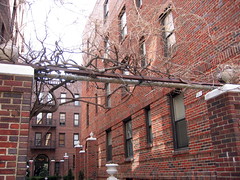Jane
Just returned from a really excellent night at the movies for a documentary filmmaker like myself.
It began with a haunting short by Bill Morrison called "Light is Calling." Morrison makes experimental films from the decomposing negatives of old silent films, and I've been wanting to see some of his work for a while. "Light" was striking in it's beauty and all-consuming in its feeling of loss.
The faces of long dead actors and actresses break through the patterns of rich brown corrosion and fade away, as if back into the ocean. The stars slip away, even as the silver halide that had preserved them decomposes beneath them.
Then came "Jane" - a 44 year old documentary chronicling Jane Fonda's broadway debut. Produced by Drew Associates, the creators of modern cinema verite, the film is a surprisingly honest and intimate portrait of a young, slightly delusional starlet who desperately wants to impress her father, who doesn't even send flowers (her brother, Peter Fonda does, however). The film is simply incredible, the best of what documentary can do with any subject.
The filmmakers, Hope Ryden and D.A. Pennebaker attended the screening and their q & a was one of the best I've ever attended. Here's some of what they said:
1. After filming, Fonda was so used to having Hope and D.A. with her that she asked them to keep filming for her next project (they declined).
2. Hope originally considered documenting Liza Minelli, and Liza was game, but her agent nixed it, telling the filmmakers that "she doesn't look good from all angles."
3. Pennebaker shot the film using cameras he made himself, as there were no battery operated cameras that held more than 3 minutes of film on the market.
4. At one point in the film, a woman enters Fonda's dressing room with a newspaper under her arm. The headline reads, "U.S. Missile Crisis". The film was shot during the Cuban Missile Crisis. The filmmakers heard that the crisis had ended one day when Pennebaker's 12 year old daughter barged into Fonda's dressing room saying, "Khrushchev is a coward."
5. The biggest problem Hope had in terms of getting access to the theater was Actor's Equity. The union insisted that she pay all the actors if she filmed. She finally had to screen the other Drew Associates movies for them, so they understood what a documentary was.
6. On the road, the show was struggling so badly that they were rewriting it on the train between cities. At one point, they asked Pennebaker and Ryden to rewrite the first act.
It began with a haunting short by Bill Morrison called "Light is Calling." Morrison makes experimental films from the decomposing negatives of old silent films, and I've been wanting to see some of his work for a while. "Light" was striking in it's beauty and all-consuming in its feeling of loss.
The faces of long dead actors and actresses break through the patterns of rich brown corrosion and fade away, as if back into the ocean. The stars slip away, even as the silver halide that had preserved them decomposes beneath them.
Then came "Jane" - a 44 year old documentary chronicling Jane Fonda's broadway debut. Produced by Drew Associates, the creators of modern cinema verite, the film is a surprisingly honest and intimate portrait of a young, slightly delusional starlet who desperately wants to impress her father, who doesn't even send flowers (her brother, Peter Fonda does, however). The film is simply incredible, the best of what documentary can do with any subject.
The filmmakers, Hope Ryden and D.A. Pennebaker attended the screening and their q & a was one of the best I've ever attended. Here's some of what they said:
1. After filming, Fonda was so used to having Hope and D.A. with her that she asked them to keep filming for her next project (they declined).
2. Hope originally considered documenting Liza Minelli, and Liza was game, but her agent nixed it, telling the filmmakers that "she doesn't look good from all angles."
3. Pennebaker shot the film using cameras he made himself, as there were no battery operated cameras that held more than 3 minutes of film on the market.
4. At one point in the film, a woman enters Fonda's dressing room with a newspaper under her arm. The headline reads, "U.S. Missile Crisis". The film was shot during the Cuban Missile Crisis. The filmmakers heard that the crisis had ended one day when Pennebaker's 12 year old daughter barged into Fonda's dressing room saying, "Khrushchev is a coward."
5. The biggest problem Hope had in terms of getting access to the theater was Actor's Equity. The union insisted that she pay all the actors if she filmed. She finally had to screen the other Drew Associates movies for them, so they understood what a documentary was.
6. On the road, the show was struggling so badly that they were rewriting it on the train between cities. At one point, they asked Pennebaker and Ryden to rewrite the first act.






0 Comments:
Post a Comment
<< Home